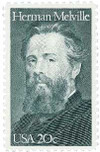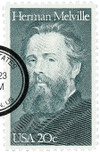
# 2094 - 1984 20c Literary Arts: Herman Melville
U.S. #2094
1984 20¢ Herman Melville
Literary Arts
- Issued on Melville’s 165th birthday
- Fourth honoree in the Literary Arts Series
- Second US postal item to honor Herman Melville
Stamp Category: Commemorative
Series: Literary Arts
Value: 20¢, rate for first-class mail
First Day of Issue: August 1, 1984
First Day City: New Bedford, Massachusetts
Quantity Issued: 117,125,000
Printed by: Bureau of Engraving and Printing
Printing Method: Engraved
Format: Panes of 50 in sheets of 200
Perforations: 11
Color: Sage green
Why the stamp was issued: For Melville’s 165th birth anniversary.
In 1970, a stamped envelope picturing a white whale was issued in honor of Melville (US #U554). It was the first US stamped envelope that didn’t include a “c” or “cents” alongside the denomination. In 2001, an American Illustrators stamp honoring Rockwell Kent (US #3502q) depicted one of the artist’s illustrations for a 1930 reprinting of Moby Dick.
About the stamp design: Stamp designer Bradbury Thompson based the stamp portrait on a painting by J.O. Eaton from the collections of Harvard University.
First Day City: This stamp was issued at the Whaling Museum in New Bedford, Massachusetts.
About the Literary Arts Series: The Literary Arts Series began in 1979 with a John Steinbeck stamp. (Click here to get every stamp in the series issued from 1979 to 2021.) The objective of the Literary Arts Series is to honor America’s most renowned authors. As the USPS put it, “These skillful wordsmiths spun our favorite tales – and American history along with them.” The series honors both well-known and lesser-known authors, making it like an encapsulation of America’s rich and varied literary history.
History the stamp represents: Herman Melville was born on August 1, 1819, in New York City. His father was an unsuccessful merchant who died suddenly when Melville was a child, forcing him and his siblings to work in the family’s fur business. Melville also held a variety of odd jobs – teaching, working on his uncle’s farm, and as a cashier in a local bank.
Though he had dropped out of school to work, Melville spent much of his free time reading. He loved mythology, anthropology, and history. And he loved hearing the story of the whaleship Essex, which was sunk by a whale when he was a year old. He developed an early fascination with whales and the whalers who hunted them.
When he was 20, he traveled across the Atlantic for the first time as a cabin boy aboard the St. Lawrence. He then spent a year and a half on the whaling ship Acushnet, followed by several months on other ships, a brief stint in jail (for mutiny), and finally, the US Navy, which brought him back to America. The adventures he had during those three years would provide him with ample inspiration for his first few novels.
Melville published his first novel, Typee, in 1846. The book was a success and spurred a sequel. Melville wrote another three relatively successful books before he was inspired to write Moby-Dick.
Melville realized that no books up to that time showed the excitement of the whaling industry as he had experienced it. The sinking of the Nantucket whaleship Essex and the alleged killing of the albino sperm whale, Mocha Dick, in the 1830s, further inspired him. Mocha reportedly had countless scars from harpoons and attacked over 100 ships.
The writing process took Melville about a year and a half. It’s been suggested he composed the book in two or three stages, rewriting much of the book to make it “an epic of cosmic proportions.” The book was first published in London, on October 18, 1851, as The Whale. British editors made hundreds of revisions that didn’t appear in the American publication.
By November 14, 1851, when Harper Brothers published the book in America, Melville changed the title to Moby-Dick. Critics and readers of the time misunderstood it. Melville used stylized language, symbolism, and metaphor to address several complicated themes such as class, social status, good and evil, and the existence of gods. The story also darkly dealt with obsession, religion, and idealism versus pragmatism, revenge, sanity, hierarchical relationships, and politics. On several occasions, the main character, Ishmael, described different aspects of the whaling business in great detail.
Moby-Dick is often seen as the start of Melville’s literary descent. Though he continued writing for a time, it wasn’t making him enough money to pay his bills, so he got a job as a customs inspector. About 3,200 copies of the book were sold during Melville’s lifetime, earning him just $1,200. He died from a heart attack on September 28, 1891.
Despite Moby-Dick’s poor reception when it was published, by the early 1900s critics and readers alike recognized it as a great literary work. Today, it is regarded as one of the greatest masterpieces of both American and world literature. In 1982, Melville was the first author to have his works collected and published by the Library of America. And in 2010, a species of extinct whale was named in his honor – Livyatan melvillei.
U.S. #2094
1984 20¢ Herman Melville
Literary Arts
- Issued on Melville’s 165th birthday
- Fourth honoree in the Literary Arts Series
- Second US postal item to honor Herman Melville
Stamp Category: Commemorative
Series: Literary Arts
Value: 20¢, rate for first-class mail
First Day of Issue: August 1, 1984
First Day City: New Bedford, Massachusetts
Quantity Issued: 117,125,000
Printed by: Bureau of Engraving and Printing
Printing Method: Engraved
Format: Panes of 50 in sheets of 200
Perforations: 11
Color: Sage green
Why the stamp was issued: For Melville’s 165th birth anniversary.
In 1970, a stamped envelope picturing a white whale was issued in honor of Melville (US #U554). It was the first US stamped envelope that didn’t include a “c” or “cents” alongside the denomination. In 2001, an American Illustrators stamp honoring Rockwell Kent (US #3502q) depicted one of the artist’s illustrations for a 1930 reprinting of Moby Dick.
About the stamp design: Stamp designer Bradbury Thompson based the stamp portrait on a painting by J.O. Eaton from the collections of Harvard University.
First Day City: This stamp was issued at the Whaling Museum in New Bedford, Massachusetts.
About the Literary Arts Series: The Literary Arts Series began in 1979 with a John Steinbeck stamp. (Click here to get every stamp in the series issued from 1979 to 2021.) The objective of the Literary Arts Series is to honor America’s most renowned authors. As the USPS put it, “These skillful wordsmiths spun our favorite tales – and American history along with them.” The series honors both well-known and lesser-known authors, making it like an encapsulation of America’s rich and varied literary history.
History the stamp represents: Herman Melville was born on August 1, 1819, in New York City. His father was an unsuccessful merchant who died suddenly when Melville was a child, forcing him and his siblings to work in the family’s fur business. Melville also held a variety of odd jobs – teaching, working on his uncle’s farm, and as a cashier in a local bank.
Though he had dropped out of school to work, Melville spent much of his free time reading. He loved mythology, anthropology, and history. And he loved hearing the story of the whaleship Essex, which was sunk by a whale when he was a year old. He developed an early fascination with whales and the whalers who hunted them.
When he was 20, he traveled across the Atlantic for the first time as a cabin boy aboard the St. Lawrence. He then spent a year and a half on the whaling ship Acushnet, followed by several months on other ships, a brief stint in jail (for mutiny), and finally, the US Navy, which brought him back to America. The adventures he had during those three years would provide him with ample inspiration for his first few novels.
Melville published his first novel, Typee, in 1846. The book was a success and spurred a sequel. Melville wrote another three relatively successful books before he was inspired to write Moby-Dick.
Melville realized that no books up to that time showed the excitement of the whaling industry as he had experienced it. The sinking of the Nantucket whaleship Essex and the alleged killing of the albino sperm whale, Mocha Dick, in the 1830s, further inspired him. Mocha reportedly had countless scars from harpoons and attacked over 100 ships.
The writing process took Melville about a year and a half. It’s been suggested he composed the book in two or three stages, rewriting much of the book to make it “an epic of cosmic proportions.” The book was first published in London, on October 18, 1851, as The Whale. British editors made hundreds of revisions that didn’t appear in the American publication.
By November 14, 1851, when Harper Brothers published the book in America, Melville changed the title to Moby-Dick. Critics and readers of the time misunderstood it. Melville used stylized language, symbolism, and metaphor to address several complicated themes such as class, social status, good and evil, and the existence of gods. The story also darkly dealt with obsession, religion, and idealism versus pragmatism, revenge, sanity, hierarchical relationships, and politics. On several occasions, the main character, Ishmael, described different aspects of the whaling business in great detail.
Moby-Dick is often seen as the start of Melville’s literary descent. Though he continued writing for a time, it wasn’t making him enough money to pay his bills, so he got a job as a customs inspector. About 3,200 copies of the book were sold during Melville’s lifetime, earning him just $1,200. He died from a heart attack on September 28, 1891.
Despite Moby-Dick’s poor reception when it was published, by the early 1900s critics and readers alike recognized it as a great literary work. Today, it is regarded as one of the greatest masterpieces of both American and world literature. In 1982, Melville was the first author to have his works collected and published by the Library of America. And in 2010, a species of extinct whale was named in his honor – Livyatan melvillei.










